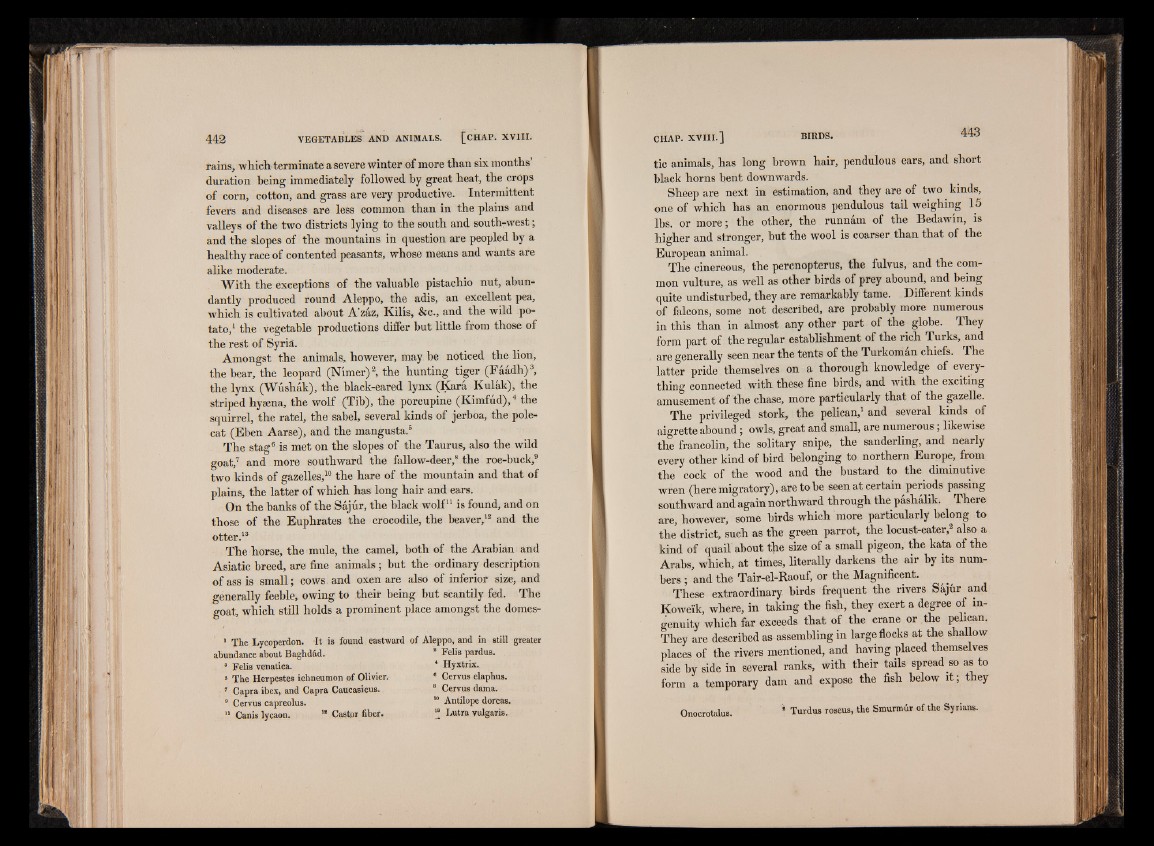
rains, which terminate a severe winter of more than six months’
duration being immediately followed by great heat, the crops
of corn, cotton, and grass are very productive. Intermittent
fevers and diseases are less common than in the plains and
valleys of the two districts lying to the south and south-west;
and the slopes of the mountains in question are peopled by a
healthy race of contented peasants, whose means and wants are
alike moderate.
With the exceptions of the valuable pistachio nut, abundantly
produced round Aleppo, the adis, an excellent pea,
which is cultivated about A’zaz, Kills, &c., and the wild potato,
1 the vegetable productions differ but little from those of
the rest of Syria.
Amongst the animals, however, may be noticed the lion,
the bear, the leopard (Nimer)2, the hunting tiger (Faadh)3,
the lynx (Wushak), the black-eared lynx (Kara Kulak), the
striped hyaena, the wolf (Tib), the porcupine (Kimfud),4 the
squirrel, the ratel, the sabel, several kinds of jerboa, the polecat
(Eben Aarse), and the mangusta.5
The stag6 is met on the slopes of the Taurus, also the wild
goat,7 and more southward the fallow-deer,8 the roe-buck,9
two kinds of gazelles,10 the hare of the mountain and that of
plains, the latter of which has long hair and ears.
On the banks of the Sajur, the black wolf11 is found, and on
those of the Euphrates the crocodile, the beaver,12 and the
otter.13
The horse, the mule, the camel, both of the Arabian and
Asiatic breed, are fine animals; but the ordinary description
of ass is small; cows and oxen are also of inferior size, and
generally feeble, owing to their being but scantily fed. The
goat, which still holds a prominent place amongst the domesI
The Lycoperdon. I t is found eastward of Aleppo, and in still greater
abundance about Baghdad. 3 Felis pardus.
3 Felis venatica. 4 Hyxtfix.
» The Herpestes ichneumon of Olivier. 8 Cervus elaphus.
7 Capra ibex, and Capra Caucasicus. 8 Cervus dama.
8 Cervus capreolus. 10 Antilope dorcas.
II Canis lycaon. Jf Castor fiber. 18 Lutra vulgaris.
tic a n im a ls , has long brown hair, pendulous ears, and short
black horns bent downwards.
Sheep are next in estimation, and they are of two kinds,
one of which has an enormous pendulous tail weighing 15
lbs. or more; the other, the runnam of the Bedawin, is
higher and stronger, but the wool is coarser than that of the
European animal.
The cinereous, the percnopterus, the fulvus, and the common
vulture, as well as other birds of prey abound, and being
quite undisturbed, they are remarkably tame. Different kinds
of falcons, some not described, are probably more numerous
in this than in almost any other part of the globe. They
form part of the regular establishment of the rich Turks, and
are generally seen near the tents of the Turkoman chiefs. The
latter pride themselves on a thorough knowledge of everything
connected with these fine birds, and with the exciting
amusement of the chase, more particularly that of the gazelle.
The privileged stork, the pelican,1 and several kinds of
aigrette abound; owls, great and small, are numerous; likewise
the francolin, the solitary snipe, the sanderling, and nearly
every other kind of bird belonging to northern Europe, from
the cock of the wood and the bustard to the diminutive
wren (here migratory), are to be seen at certain periods passing
southward and again northward through the pashalik. There
are, however, some birds which more particularly belong to
the district, such as the green parrot, the locust-eater,2 also a
kind of quail'about the size of a small pigeon, the kata of the
Arabs, which, at times, literally darkens the air by its numbers
; and the Tair-el-Raouf, or the Magnificent.
These extraordinary birds frequent the rivers Sajur and
Koweik, where, in taking the fish, they exert a degree of ingenuity
which far exceeds that of the crane or the pelican.
They are described as assembling in large flocks at the shallow
places of the rivers mentioned, and having placed themselves
side by side in several ranks, with their tails spread so as to
form a temporary dam and expose the fish below it; they
Onocrotalus. * Turdus roseus, the Smurmur of the Syrians.